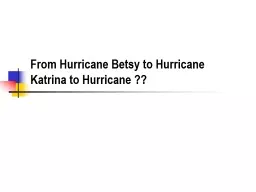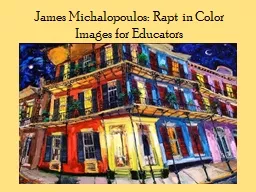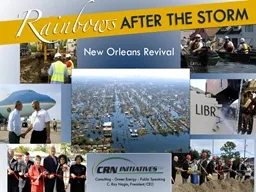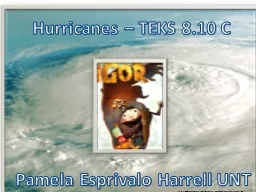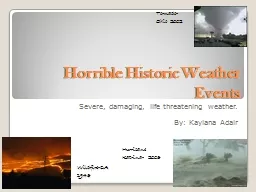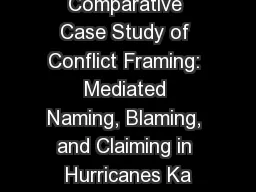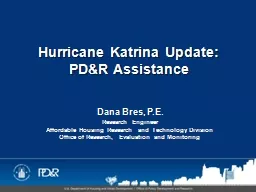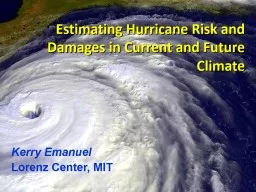PPT-From Hurricane Betsy to Hurricane Katrina to Hurricane ??
Author : phoebe-click | Published Date : 2019-11-22
From Hurricane Betsy to Hurricane Katrina to Hurricane 2 Flood Control Act of 1928 What happened in 1927 What are the immunity provisions Flood Control Act of 1928
Presentation Embed Code
Download Presentation
Download Presentation The PPT/PDF document "From Hurricane Betsy to Hurricane Katrin..." is the property of its rightful owner. Permission is granted to download and print the materials on this website for personal, non-commercial use only, and to display it on your personal computer provided you do not modify the materials and that you retain all copyright notices contained in the materials. By downloading content from our website, you accept the terms of this agreement.
From Hurricane Betsy to Hurricane Katrina to Hurricane ??: Transcript
From Hurricane Betsy to Hurricane Katrina to Hurricane 2 Flood Control Act of 1928 What happened in 1927 What are the immunity provisions Flood Control Act of 1928 33 U S C 702c which states that no liability of any kind shall attach to or rest upon the United States for any damage from or by floods or flood waters at any place. Hurricane Katrina - 2005. The most destructive (in terms of property damage and cost) natural disaster in US history.. Approximately 1800 directly related deaths, countless indirectly related. One of the most powerful hurricanes – winds over 250km/h. Michalopoulos. : Rapt in Color. Images for Educators. Examples of Building Styles found in New Orleans. These buildings are traditional New Orleans building styles. They were build before Hurricane Katrina. These are the styles you will see in the paintings of James . Story of Determination, Resiliency & Overcoming. Governments Role; Struggles After Katrina. Share Hard Lessons Learned. Importance . Of . Timely Investment/Preparedness . Hurricane Katrina: rainbows after the storm. Tactile . Talk: . . The . Tactile Communication . and Literacy . Toolkit for . iPad. Lightweight . and. . p. ortable. Ability to quickly change tactile overlays. Ability to customize. Advantages of iDevice. http://www.dannylipford.com/images/article/how-prepare-hurricane-1.jpg. Pamela . Esprivalo. Harrell UNT. http://www.ssd.noaa.gov/goes/east/tatl/flash-vis.html. http://1.bp.blogspot.com/_cudK8MwW64I/SOS-fn500eI/AAAAAAAAHGo/onP6gsC8R4I/s400/igor.jpg. Reactions. Nemeth, . D.. 1. , . Kuriansky, . J.. 2. , Olivier. , . T.. 1. , . Whittington, . L.. 1. , . May, . N.. 1. , . Hamilton, . J.. 1. , . Steger, . A. .. 1. Neuropsychology Center of Louisiana, . Severe, damaging, life threatening weather.. By: . Kaylana. Adair. Hurricane Katrina- 2006. Wildfire-CA 1946. Tornado-Ohio 2002. Hurricane Katrina. When Hurricane Katrina struck the east coast…. What it looked like…. ABC Biography. By Corrine Blazek. A is American flag. It is believed that Betsy Ross made the American flag.. B is for born. January 1, 1782 was the date of Betsy’s birth.. C is for children. She had seven daughters.. HAPPY WEDNESDAY!. Copy Homework. Have . outs:. Pen/pencil. Homework [plot line] in a pile at the center of your desk. Reading Mini-Lesson 15. Writing Mini-Lesson . 11 [given yesterday]. Leadership . Models appropriate behavior to classmates. ICRC 2017. R. Tyler Spradley, Associate Professor SFASU. –The Federal Response to Hurricane Katrina: Lessons Learned. “The magnitude of Hurricane Katrina does not excuse our inadequate preparedness and response, but rather it must serve as a catalyst for far-reaching reform and transformation.” . PD&R Assistance. Dana Bres, P.E.. Research Engineer. Affordable Housing Research and Technology Division. Office of Research, Evaluation and Monitoring. Hurricane Katrina. Landfall on 29 August 2005. Group Interventions for Disaster/Trauma Anniversary Reactions Nemeth, D. 1 , Kuriansky, J. 2 , Olivier , T. 1 , Whittington, L. 1 , May, N. 1 , Hamilton, J. 1 , Steger, A . 1 Neuropsychology Center of Louisiana, Robert M. McNab. Dragas Center for Economic Analysis and Policy. Strome College of Business. Old Dominion University. June 3, 2019. A Major Hurricane is Uncertain but Also Certain. 2. Numerous storms have tracked over or west of Hampton Roads since 1850. . Kerry Emanuel. Lorenz Center, MIT. Walter Orr Roberts. (1915-1990). Dedicated to Science in the Service of Society. Program. Hurricanes and Hurricane Disasters. Hurricane Impacts. Societal Response to Hurricanes.
Download Document
Here is the link to download the presentation.
"From Hurricane Betsy to Hurricane Katrina to Hurricane ??"The content belongs to its owner. You may download and print it for personal use, without modification, and keep all copyright notices. By downloading, you agree to these terms.
Related Documents

